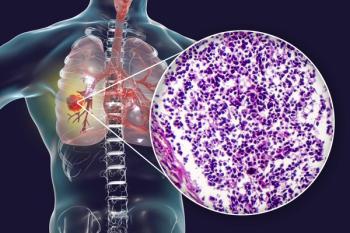
Low/No PSMA Expressing mCRPC Tumors Respond Poorly to 177Lu-PSMA-617 Therapy
Treatment with 177Lu-PSMA-617 resulted in poor outcomes for patients with metastatic castration-resistant prostate cancer whose tumors had little to no prostate-specific membrane antigen expression.
Patients with metastatic castration-resistant prostate cancer (mCRPC) whose tumors had low or no prostate-specific membrane antigen (PSMA) expression experienced poor responses following treatment with 177Lu-PSMA-617 therapy, according to findings from a multicenter retrospective analysis presented at the
Baseline PSMA-PET/CT scans were assessed by 1 reader who applied PET criteria from the phase 3 VISION trial (NCT03511664) and determine whether scans were eligible (VISION-PET-E) or a screening failure (VISION-PET-SF).
VISION-PET-SF criteria were defined by the following:
- Lack of metastatic lesion with an uptake greater than the liver background, denoting low PSMA expression
- Evidence of 1 or more metastatic measurable lesions
- Solid/visceral organ lesions
Moreover, VISION-PET-E criteria included the following:
- 1 or more PSMA-positive metastatic lesions
- No PSMA-negative metastatic lesions, including bone with soft tissue component (1.0 cm or more), lymph node (2.5 cm or more), and solid organ (1.0 cm or more)
In the VISION-PET-SF population, investigators reported that PSA–progression-free survival (PSA-PFS) was shorter, and poorer outcomes were all noted for PSA responses and overall survival (OS). In particular, the median PSA-PFS was 4.1 months in the VISION-PET-E arm vs 2.1 months in the VISION-PET-SF arm (HR, 1.6; 95% CI, 1.1-2.5; P = .025; log-rank P-value = .023). Moreover, the median OS was 14.2 months compared with 9.6 months in the VISION-PET-E arm and VISION-PET-SF arm, respectively (HR, 1.4; 95% CI, 0.89-2.3; P = .16; log-rank P-value = .16).
Any PSA decline was noted in 71.3% of patients in the VISION-PET-E arm vs 41.4% in the VISION-PET-SF arm (P = .003). Moreover, a PSA decline of 50% or more was reported in 50.3% and 20.7% of patients in either respective arms (P = .005).
A total of 304 patients with mCRPC were included in the analysis who had received 1 or more cycles of 177Lu-PSMA-617. Of these patients, 3 were excluded due to being lost to follow-up (n = 2) or missing a CT image (n = 1). From there, patients were assessed based on VISION PET criteria, of whom 272 were VISION-PET-E and 29 were VISION-PET-SF.
Outcomes included PSA-PFS, OS, PSA decline of 50% or more, and any PSA decline.
Notably, the cohort did not include pre-excluded patients via local site evaluation. Due to this, approximately 20% to 25% of patients in the unselected group would likely have failed screening via VISION PET criteria.
Reference
Hotta M, Gafita A, Czernin J, et al. Outcome of patients with PSMA-PET/CT screen failure by VISION criteria and treated with 177Lu-PSMA therapy: a multicenter retrospective analysis. 2022 Society of Nuclear Medicine & Molecular Imaging Annual Meeting; June 11-14; Vancouver, BC, Canada; abstract 3039.
Newsletter
Stay up to date on recent advances in the multidisciplinary approach to cancer.


















































































